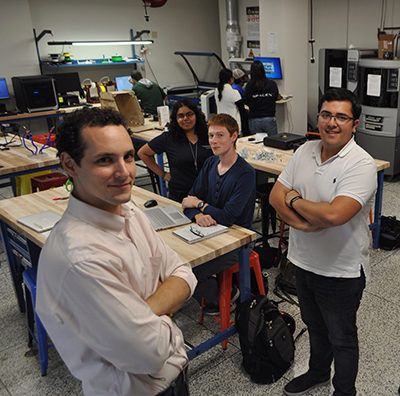 |
| Prof. Claudio Di Leo, foreground, is seen here with some of the student officers who help run the AE Aero Maker Space. Di Leo's colleague, Dr. Mark Costello spearheaded efforts to fund the School's newest maker space, located in the Weber Building. |
Its posted hours are Monday through Friday, 9 to 5, but the new Aero Maker Space never seems entirely closed for business.
The 3D printers are always whirring
The scent of singed wood from the laser cutters is always in the air.
And, most of the time, there are clots of students, bent over laptops, clustered around printers, or excitedly discussing their next project.
“I spend all of my free time here,” says Martin Kurien, a third-year AE major, one of six student officers who oversee the space under the direction of Prof. Claudio Di Leo.
“I am minoring in computer science, because I thought I wanted to go into computational fluid dynamics, but this has really gotten me interested in manufacturing composites.”
Located on the second floor of the Weber Building, the Aero Maker Space has become the go-to place for students like Kurien who want to build and test the projects that they’ve spent countless hours designing for their classes and competitions. It’s also a place where their nascent creativity can take root.
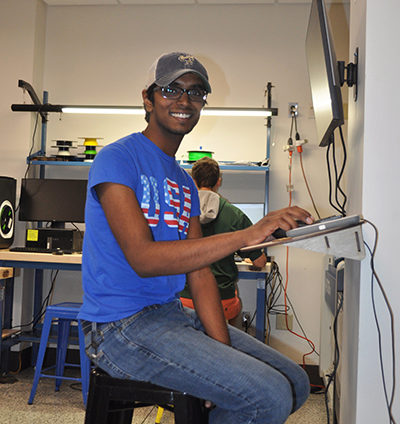 |
| Keeping Things Safe. AE undergraduate Martin Kurien is the safety officer for the newly opened Aero Maker Space in the Weber Building. |
“The curiosity that brings them through the doors of the Aero Maker Space is what’s going to make them better engineers,” says Di Leo.
“When students realize that they can bring their ideas to life, that they can use the laser cutter, the 3D printer, the wood working equipment to create and test a prototype, it makes them more focused, more motivated.”
Not to mention more creative.
A line of whimsical laser-cut and 3D printed objects lines the window sill that faces out into the Weber foyer: a bust of Albert Einstein, a dinosaur cup, a Pegasus figurine. Students are encouraged to hone their skills on the equipment by manufacturing anything they can get into a CAD design. Kurien laser engraved his resume onto wood, steel, and acrylic plates.
“I haven’t tried submitting it anywhere yet,” he said.
The prototyping and manufacturing facilities in the Aero Maker Space are available to all properly trained Georgia Tech students and faculty. A team of 20 AE student mentors have been trained to instruct their peers and oversee the use of the equipment. Of that number, six are official AMS student officers who help Di Leo manage the day-to-day running of the studio.
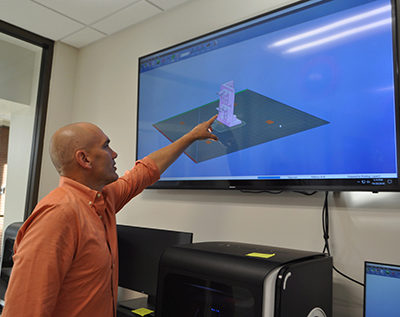 |
| Prof. Mark Costello reviews designs for a component that will be manufactured at the Aero Maker Studio |
“We have student officers overseeing a lot of the management, like safety and curriculum integration,” says Di Leo. “It’s a great way for them to learn how to set up and manage a lab – something they might be asked to do some day on the job.”
Together, the mentors and officers staff the facility during posted hours, but they are often found in the studio long after it has closed.
“It’s cool because students come to the window and stare at our machines and we are able to invite them in, to show them how to use the equipment,” says Avani Gupta, an AE Honors student and AMS officer.
“We are also working with the AE curriculum to get classes in here to build their prototypes. Right now, we’re working with the Intro AE class, helping them to manufacture the balsa wood airplanes for their competition, but there’s lots more we can do.”
Technically, there are four facilities under the Aero Maker Space umbrella: prototyping, wood working, metal working, and composites manufacturing. The prototyping and wood working facilities are located in the Weber building, while the metal working and composites manufacturing facility are located in Montgomery Knight rooms 105 and 110 respectively.
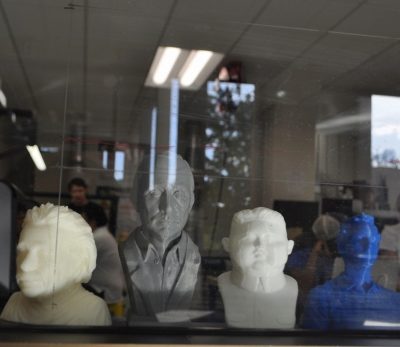 |
| "Albert Einstein, Vladimir Putin and Kim Jong Il walk into a lab..."These plastic busts of famous (and infamous) individuals were manufactured by AE students who were learning how to use a 3D scanner, a CAD program and a 3D printer. to create components for their prototypes. |
With its flickering LED signage and windowed façade, the Weber facility is the most publicly celebrated member of the Aero Maker Space family. It is equipped with eight consumer-grade 3D printers, two professional-grade 3D printers, two laser cutters, an electronics workbench and all manner of hand and power tools. The wood working facility located in the back room is equipped with standard wood working equipment as well as a vacuum former and CNC foam cutter.
“We will be fully opening the wood working area next semester,” said Di Leo. “That requires more training.”
Across the street, the composites manufacturing facility is equipped with vacuum bagging equipment and pumps as well as a large format curing oven. The professionally staffed metal working machine shop is equipped with manual and CNC lathes and mills, wire EDM, welding, and a large format CNC router.
The Aero Maker Space facilities are increasingly popular among faculty, who are taking advantage of the rapid prototyping capabilities to teach basic principles to their students. The Senior Design class students are also expected to be flocking to the AMS to complete their projects. The AMS team looks forward forging multiple relationships with students, faculty, and researchers.
"We're manufacturing composite components for robotic landing gear for helicopters,” says Kurien, who works with professors Di Leo and Costello on a DARPA-funded project. “It’s really cool because we were able to create the mold, cover it with carbon-fiber cloth, infuse it with epoxy, and cure it with the vacuum mold.
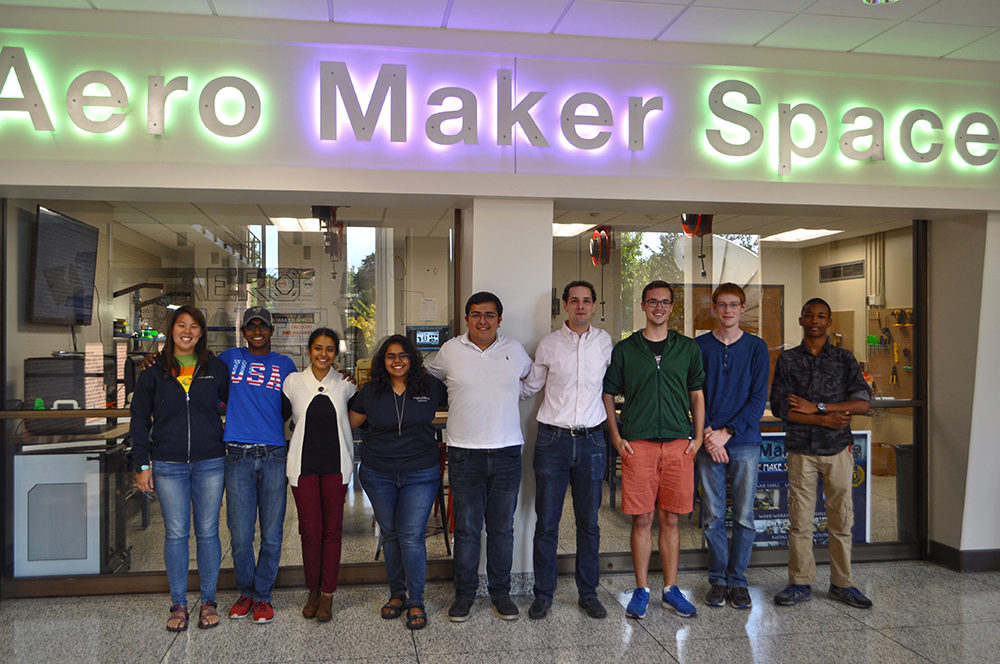 |